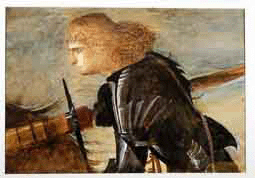Upper Part of the Figure of St George, after Carpaccio
John Ruskin (1819-1900). Watercolour and bodycolour on paper, 1872
Ruskin on CarpaccioCook and Wedderburn note that Ruskin's praise of Carpaccio came mainly in later works, such as Guide to the Principal Pictures in the Academy of Fine Arts at Venice (1877) and St Mark's Rest (1877-84), and that in The Stones of Venice (1851; 1853) Carpaccio is 'referred to only for his interesting pieces of Venetian architecture (Works, 4, p. 356).As in several other areas of his life, Ruskin's enthusiasm for Carpaccio was based on a 'conversion' experience. On the advice of Edward Burne-Jones, he sought Carpaccio out on visiting Venice in 1869, and wrote back to his friend to acknowledge the injustice of past neglect: 'MY DEAREST NED, -- There's nothing here like Carpaccio! There's a little bit of humble-pie for you!' (May 13th 1869; Works, 4, p. 356).Ruskin was especially attracted to Carpaccio’s cycle of paintings in the Scuola di San Giorgio degli Schiavoni. In St Mark's Rest, he explains that this institution was founded in 1451 by Slavonic benefactors, to aid poor sailors who were fellow-countrymen. Ruskin proceeds to describe his impressions of the interior:'Entering, we find ourselves in a little room about the size of a commercial parlour in an old-fashioned English inn; perhaps an inch or two higher in the ceiling, which is of good horizontal beams, narrow and many, for effect of richness; painted and gilded, also now, tawdrily enough, but always in some such patterns as you see (Works, 24, p. 338)'.He then invites us to 'go round the room to know what is here to read':'First, on the left, then, St. George and the Dragon -- combatant both, to the best of their powers; perfect each in their natures of dragon and knight. No dragon that I know of, pictured among mortal worms; no knight I know of, pictured in immortal chivalry, so perfect, each in his kind, as these two. What else is visible on the battle-ground, of living creature, -- frog, newt, or viper, -- no less admirable in their kind. The small black viper, central, I have painted carefully for the schools of Oxford as a Natural History study, such as Oxford schools prefer. St. George, for my own satisfaction, also as well as I could, in the year 1872; and hope to get him some day better done, for an example to Sheffield in iron-armour, and several other things.' (Works, 24, p. 341).
Collection of the Guild of St George, Museums Sheffield
In the event, Ruskin produced two studies of this work, the first a sketch of the whole painting, and the other the watercolour displayed here showing only the upper part of St George's figure.
Ruskin on St GeorgeSt George was England’s patron saint, but also an important figure in the iconography of Venice. Always interested in the links between those two sea-going empires, Ruskin saw St George as a shared object of veneration.His choice of name for the Museum also reflected a longstanding interest in the legend of St George. At the age of just nine or ten years old, he evoked the character of this hero of chivalry in a poem: ‘“I am the bravest Knight of all’, it reads, ‘My armour is of gold;
/ O'er all the field death spreads his pall /
When I my wrath unfold.â€â€™ (Works, 2, p. xxxiii). Ruskin’s fascination with the legend took different forms in later life. In particular, he came to associate dragon-slaying with the fight against social injustice. The dragon represented not just the 'enemy of mankind', but also the fire and smoke expelled by England's industrial enterprises.In Fors Clavigera (February 1873), Ruskin noted of Carpaccio’s representation that ‘His St. George exactly reverses the practice of ours’, in that ‘He rides armed, from shoulder to heel, in proof – but without his helmet.’ (Works, 27, p. 475). He explains that ‘the real difficulty in dragon-fights [...] is not so much to kill your dragon, as to see him; at least to see him in time, it being too probable that he will see you first.’ We might consider the Museum in this, symbolic, light. It is an attempt to ‘see’ the dragon first, to take the initiative in the fight to teach better ways of witnessing the world. |



















